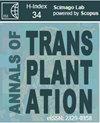A Systematic Review of the Literature on Chronic Kidney Disease Following Liver Transplantation
IF 1.1
4区 医学
Q3 SURGERY
引用次数: 2
Abstract
Chronic kidney disease (CKD) is a serious comorbidity affecting liver transplant recipients (LTRs). Calcineurin inhibitor dosing minimization protocols and everolimus use purportedly increased from 2010, potentially impacting CKD development. This systematic literature review was designed to identify CKD incidence in adult LTRs, focusing on studies published from 2010 onwards. PubMed, Embase, and the Cochrane Database of Systematic Reviews were searched for papers reporting renal function (glomerular filtration rate [GFR]; estimated GFR [eGFR] or Chronic Kidney Disease Epidemiology Collaboration) for adult LTRs ≥6 months after transplantation. Primary outcome: renal function ≥6 months after transplantation, with CKD stage. Bias was assessed using the Cochrane Collaboration bias tool and by reviewing disclosures/industry funding. Of 3960 records identified, 14 publications were included. In at least 1 study arm, mean GFR/eGFR remained stable/improved temporally in 4 and decreased in 8 publications. Where GFR/eGFR decreased, mean eGFR was 71.4–119.6 mL/min/1.73 m2 (CKD stage 2-stage 1) across studies at baseline, and was 77.2 and 79.1 mL/min/1.73 m2 (stage 2) at 12 months. The proportion of patients with CKD increased between baseline and follow-up; 23.2–36.8% of patients had CKD stage 3a or higher at 12 months (2 studies). Rates ranged from 85.7–100% (6 months) for patient survival, 81.0% (12 months) to 100.0% (17 months) for graft survival, and 0–40% (12 months) for acute rejection. Most studies carried risk of bias. Evidence of temporal renal function decline highlights the need for continuous renal monitoring of LTRs, particularly regarding potential CKD development/progression.肝移植后慢性肾病的文献系统综述
慢性肾脏疾病(CKD)是影响肝移植受者(lts)的严重合并症。钙调磷酸酶抑制剂剂量最小化方案和依维莫司的使用据称从2010年开始增加,可能影响CKD的发展。本系统文献综述旨在确定成人ltr的CKD发病率,重点关注2010年以来发表的研究。检索PubMed、Embase和Cochrane系统评价数据库中有关肾功能(肾小球滤过率[GFR];成人LTRs移植后≥6个月的估计GFR [eGFR]或慢性肾脏疾病流行病学协作)。主要结局:移植后肾功能≥6个月,CKD分期。偏倚评估使用Cochrane协作偏倚工具,并通过审查披露/行业资助。在确定的3960份记录中,包括14份出版物。在至少1个研究组中,4个研究组的平均GFR/eGFR暂时保持稳定/改善,8个研究组的平均GFR/eGFR下降。当GFR/eGFR下降时,基线时研究的平均eGFR为71.4-119.6 mL/min/1.73 m2 (CKD期2- 1期),12个月时为77.2和79.1 mL/min/1.73 m2(2期)。在基线和随访期间,CKD患者的比例有所增加;23.2-36.8%的患者在12个月时CKD为3a期或更高(2项研究)。患者存活率为87% - 100%(6个月),移植物存活率为81.0%(12个月)- 100.0%(17个月),急性排斥反应存活率为0-40%(12个月)。大多数研究都存在偏倚风险。颞期肾功能下降的证据强调了对ltr进行持续肾脏监测的必要性,特别是对于潜在的CKD发展/进展。
本文章由计算机程序翻译,如有差异,请以英文原文为准。
求助全文
约1分钟内获得全文
求助全文
来源期刊
CiteScore
2.50
自引率
0.00%
发文量
79
审稿时长
>12 weeks
期刊介绍:
Annals of Transplantation is one of the fast-developing journals open to all scientists and fields of transplant medicine and related research. The journal is published quarterly and provides extensive coverage of the most important advances in transplantation.
Using an electronic on-line submission and peer review tracking system, Annals of Transplantation is committed to rapid review and publication. The average time to first decision is around 3-4 weeks. Time to publication of accepted manuscripts continues to be shortened, with the Editorial team committed to a goal of 3 months from acceptance to publication.
Expert reseachers and clinicians from around the world contribute original Articles, Review Papers, Case Reports and Special Reports in every pertinent specialty, providing a lot of arguments for discussion of exciting developments and controversies in the field.

 求助内容:
求助内容: 应助结果提醒方式:
应助结果提醒方式:


